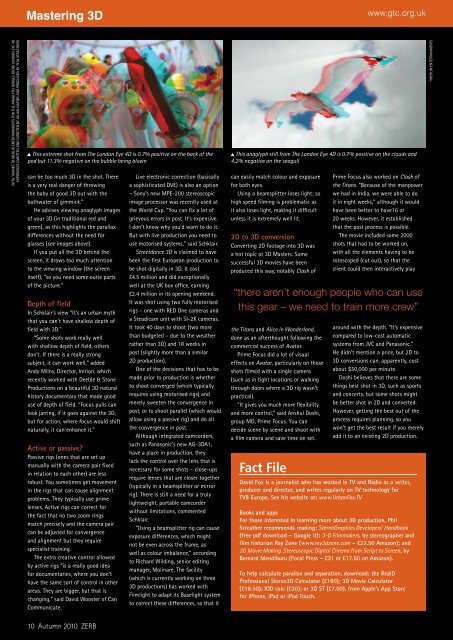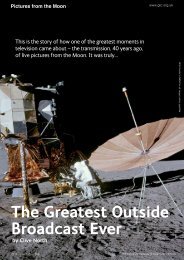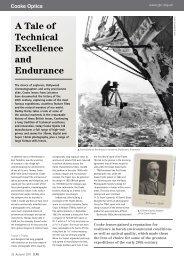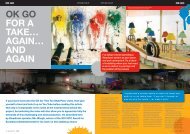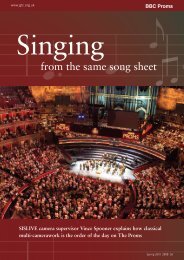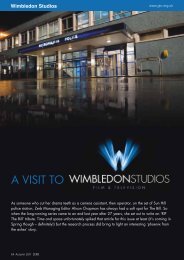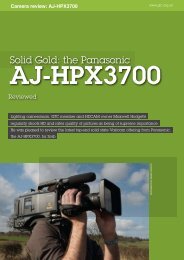Mastering 3D Mastering 3D
Mastering 3D Mastering 3D
Mastering 3D Mastering 3D
Create successful ePaper yourself
Turn your PDF publications into a flip-book with our unique Google optimized e-Paper software.
<strong>Mastering</strong> <strong>3D</strong><br />
www.gtc.org.uk<br />
With thanks to Merlin Entertainments for the anaglyph images from London Eye 4D<br />
Experience (written and directed by Julian Napier and produced by Phil Streather)<br />
This extreme shot from The London Eye 4D is 0.7% positive on the back of the<br />
pod but 11.3% negative on the bubble being blown<br />
can be too much <strong>3D</strong> in the shot. There<br />
is a very real danger of throwing<br />
the baby of good <strong>3D</strong> out with the<br />
bathwater of gimmick.”<br />
He advises viewing anaglyph images<br />
of your <strong>3D</strong> (in traditional red and<br />
green), as this highlights the parallax<br />
differences without the need for<br />
glasses (see images above).<br />
If you put all the <strong>3D</strong> behind the<br />
screen, it draws too much attention<br />
to the viewing window (the screen<br />
itself), “so you need some outie parts<br />
of the picture.”<br />
Depth of field<br />
In Schklair’s view “It’s an urban myth<br />
that you can’t have shallow depth of<br />
field with <strong>3D</strong>.”<br />
“Some shots work really well<br />
with shallow depth of field, others<br />
don’t. If there is a really strong<br />
subject, it can work well,” added<br />
Andy Milns, Director, Inition, which<br />
recently worked with Deeble & Stone<br />
Productions on a beautiful <strong>3D</strong> natural<br />
history documentary that made good<br />
use of depth of field. “Focus pulls can<br />
look jarring, if it goes against the <strong>3D</strong>,<br />
but for action, where focus would shift<br />
naturally, it can enhance it.”<br />
Active or passive?<br />
Passive rigs (ones that are set up<br />
manually with the camera pair fixed<br />
in relation to each other) are less<br />
robust. You sometimes get movement<br />
in the rigs that can cause alignment<br />
problems. They typically use prime<br />
lenses. Active rigs can correct for<br />
the fact that no two zoom rings<br />
match precisely and the camera pair<br />
can be adjusted for convergence<br />
and alignment but they require<br />
specialist training.<br />
The extra creative control allowed<br />
by active rigs “is a really good idea<br />
for documentaries, where you don’t<br />
have the same sort of control in other<br />
areas. They are bigger, but that is<br />
changing,” said David Wooster of Can<br />
Communicate.<br />
Live electronic correction (basically<br />
a sophisticated DVE) is also an option<br />
– Sony’s new MPE-200 stereoscopic<br />
image processor was recently used at<br />
the World Cup. “You can fix a lot of<br />
grievous errors in post. It’s expensive.<br />
I don’t know why you’d want to do it.<br />
But with live production you need to<br />
use motorised systems,” said Schklair.<br />
Streetdance <strong>3D</strong> is claimed to have<br />
been the first European production to<br />
be shot digitally in <strong>3D</strong>. It cost<br />
£4.5 million and did exceptionally<br />
well at the UK box office, earning<br />
£2.4 million in its opening weekend.<br />
It was shot using two fully motorised<br />
rigs – one with RED One cameras and<br />
a Steadicam unit with SI-2K cameras.<br />
It took 40 days to shoot (two more<br />
than budgeted – due to the weather<br />
rather than <strong>3D</strong>) and 18 weeks in<br />
post (slightly more than a similar<br />
2D production).<br />
One of the decisions that has to be<br />
made prior to production is whether<br />
to shoot converged (which typically<br />
requires using motorised rigs) and<br />
merely sweeten the convergence in<br />
post, or to shoot parallel (which would<br />
allow using a passive rig) and do all<br />
the convergence in post.<br />
Although integrated camcorders,<br />
such as Panasonic’s new AG-<strong>3D</strong>A1,<br />
have a place in production, they<br />
lack the control over the lens that is<br />
necessary for some shots – close-ups<br />
require lenses that are closer together<br />
(typically in a beamsplitter or mirror<br />
rig). There is still a need for a truly<br />
lightweight, portable camcorder<br />
without limitations, commented<br />
Schklair.<br />
“Using a beamsplitter rig can cause<br />
exposure differences, which might<br />
not be even across the frame, as<br />
well as colour imbalance,” according<br />
to Richard Wilding, senior editing<br />
manager, Molinare. The facility<br />
(which is currently working on three<br />
<strong>3D</strong> productions) has worked with<br />
Filmlight to adapt its Baselight system<br />
to correct these differences, so that it<br />
This anaglyph still from The London Eye 4D is 0.7% positive on the clouds and<br />
4.2% negative on the seagull<br />
can easily match colour and exposure<br />
for both eyes.<br />
Using a beamsplitter loses light; so<br />
high speed filming is problematic as<br />
it also loses light, making it difficult<br />
unless it is extremely well lit.<br />
2D to <strong>3D</strong> conversion<br />
Converting 2D footage into <strong>3D</strong> was<br />
a hot topic at <strong>3D</strong> Masters. Some<br />
successful <strong>3D</strong> movies have been<br />
produced this way, notably Clash of<br />
the Titans and Alice in Wonderland,<br />
done as an afterthought following the<br />
commercial success of Avatar.<br />
Prime Focus did a lot of visual<br />
effects on Avatar, particularly on those<br />
shots filmed with a single camera<br />
(such as in tight locations or walking<br />
through doors where a <strong>3D</strong> rig wasn’t<br />
practical).<br />
“It gives you much more flexibility<br />
and more control,” said Anshul Doshi,<br />
group MD, Prime Focus. You can<br />
decide scene by scene and shoot with<br />
a film camera and save time on set.<br />
Prime Focus also worked on Clash of<br />
the Titans. “Because of the manpower<br />
we had in India, we were able to do<br />
it in eight weeks,” although it would<br />
have been better to have16 or<br />
20 weeks. However, it established<br />
that the post process is possible.<br />
The movie included some 2000<br />
shots that had to be worked on,<br />
with all the elements having to be<br />
rotoscoped (cut out), so that the<br />
client could then interactively play<br />
“there aren’t enough people who can use<br />
this gear – we need to train more crew”<br />
Fact File<br />
around with the depth. “It’s expensive<br />
compared to low-cost automatic<br />
systems from JVC and Panasonic.”<br />
He didn’t mention a price, but 2D to<br />
<strong>3D</strong> conversions can, apparently, cost<br />
about $50,000 per minute.<br />
Doshi believes that there are some<br />
things best shot in <strong>3D</strong>, such as sports<br />
and concerts, but some shots might<br />
be better shot in 2D and converted.<br />
However, getting the best out of the<br />
process requires planning, so you<br />
won’t get the best result if you merely<br />
add it to an existing 2D production.<br />
David Fox is a journalist who has worked in TV and Radio as a writer,<br />
producer and director, and writes regularly on TV technology for<br />
TVB Europe. See his website at: www.UrbanFox.TV<br />
Books and apps<br />
For those interested in learning more about <strong>3D</strong> production, Phil<br />
Streather recommends reading: StereoGraphics Developers’ Handbook<br />
(free pdf download – Google it); 3-D Filmmakers, by stereographer and<br />
film historian Ray Zone (www.ray3dzone.com – £22.50 Amazon); and<br />
<strong>3D</strong> Movie Making: Stereoscopic Digital Cinema from Script to Screen, by<br />
Bernard Mendiburu (Focal Press – £31 or £17.50 on Amazon).<br />
To help calculate parallax and separation, download: the RealD<br />
Professional Stereo<strong>3D</strong> Calculator (£180); <strong>3D</strong> Movie Calculator<br />
(£18.50); IOD calc (£30); or <strong>3D</strong> ST (£7.50), from Apple’s App Store<br />
for iPhone, iPad or iPod Touch.<br />
©MERLIN ENTERTAINMENTS<br />
10 Autumn 2010 ZERB


